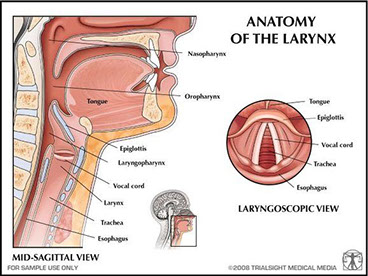
HOSTS- Jeremy Burns, Matthew Scott Phillips
TYPE- Special Topics
DURATION- 67:00
BUMPER MUSIC- "Farewell to Fiunary"
(traditional, arr. Area 47 Music)
ANNOUNCER- Mike Cunliffe
Just like any instrument, your voice needs a great amount of care and attention in order to perform at it's peak potential. If you're a singer, a public speaker, a bartender or a cheerleader, you have to use your voice at loud volumes for extended amounts of time. Let's find out how to best accomplish this while keeping your voice strong and healthy.
The voice is driven by three main systems:
1-AIr Pressure System- Lungs, diaphragm, chest muscles,
abdominal muscles.
2-Vibratory System- Voice box, glottis and vocal folds.
3-Resonating System- Throat, oral cavity and nasal passages.

photo credit: Trailsight Media, 2008
-LUNGS- Like a bellows, draws air in (with the help of the diaphragm and chest muscles) and blows it out via the TRACHEA (wind pipe). At the top of the trachea, we have the vocal mechanism, which consists of the following:
-VOCAL FOLDS (Vocal Cords)-This folded soft tissue is the main vibrating component. It consists of a cover, vocal ligament, and the body.
-GLOTTIS-Opening between the vocal folds.
1) The vocal folds move to the midline.
2) A column of air opens the folds at the bottom and moves to the top of the vocal folds.
3) The low pressure air pocket that follows, closes the lower folds, followed by the upper folds. This is known as the Bernoulli effect.
4) Closure of those top folds cut of the air column and releases a puff of air into the LARYNX. This is one cycle. This happens many times a second. Each time is a Hz.
-LARYNX-This is the cavity above your wind pipe (voice box). It is designed to aid in sound production during speech and the EPIGLOTTIS, above it, cuts off or opens airflow (open for breathing and closed while swallowing and producing sound).
1-Start off your day with quiet humming and gentle cooing.
2-Tongue and lip trills. This is good for that morning shower! Check out Dr. Daniel K. Robinson’s video, “Lip Trills: Are You Doing Them Right?”. Here's a look at the process:
-Use your fingers to brace the corner of your lips
-You have three sounds: 1-Air, 2-Lips, 3-Tone.
Tone needs to be the loudest.
-Tension in your neck and shoulders can hinder
a good sound. Make sure your breath is even
and not too hard. Trills help keep your pressure
even.
-Try not to end in a breath.
3-If warming up involves scales or melodies, start
simple. Move up and down the scale and try some arpeggios.
4-Repeat these exercises a few times throughout
the day.
5-Finally end your day with exercises similar to those which you began it with.
The following tips were drawn from:
1-Hydration- Drink plenty of water. Avoid caffeine and alcohol. Stick to water-based snacks such as fruits (grape, orange, apple, melons). Also vegetables like bell peppers or celery. Drinking ginger tea can help heal your voice if it’s in bad shape. Use honey instead of sugar if you can.
2-Allow for “vocal naps” during the day. Just what it sounds like! Find a quiet way to spend your breaks if you’re a teacher or a coach.
3-Don’t smoke. Obviously no one wants throat or lung cancer. But even inhaling second hand smoke can irritate the vocal folds. The heat from inhalation is also bad for your folds.
4-Try not to abuse or overuse your voice. Try to avoid yelling or screaming. If you are starting to feel or sound hoarse, that is a sign that your vocal mechanisms have been irritated.
5-Pay attention to your neck and throat muscles when you sing. Make sure you’re not straining them.
6-Pay attention to how you speak everyday. Many singers don’t consider this. Try to allow for more breath flow when you speak and try to avoid "vocal fry".
7-Try to avoid clearing your throat. Essentially, this is the act of slamming your vocal cords together. Alternatively, have a sip of water or just swallow to avoid throat clearing. If you feel you’re having to do this too much, maybe get checked for acid reflux or for sinus allergy concerns.
8-When you are sick, spare your voice. Don’t talk any more than you have to.
9- If speaking in public, make sure there’s a PA system involved so you don’t have to scream.
10- Back to hydration, try to regulate the humidity levels in your home or in your studio. Humidity is good for your voice.
-When is comes to the voice, is vaping better for you than smoking? This article, from VapingDaily.com, “How Vaping and Smoking Can Effect You Vocal Cords” (by Jeffery Buckly) explains that “Even though the initial response to this question is Yes, the overall answer is not that simple. E-cigarettes contain less harmful ingredients than regular cigarettes. However, that does not mean they are 100% safe and without any side effects. Depending on the quality and contents of different “vape juices”, even e-cigarettes can cause considerable damage to one’s vocal cords. In addition, it can impede an individual’s ability to use their voice properly”.
-Stay away from cold drinks, ice water included, especially before you perform. You want your vocal folds hydrated but loose! The same goes for hot beverages. Extreme temperatures are bad for any instrument!
-Don’t whisper. To produce a whisper, you have to squeeze your vocal cords together. This is traumatic to your vocal folds.
-Avoid gluten and dairy before you sing because they thicken the mucous in your throat, which can mess with your tone and range. This doesn't effect everyone the same way.
-Belching is okay unless there is acid reflux involved.
